These articles are reprinted with permission from the Nanwakolas Council website. To view the original articles, please visit Guardians in Training and A Family of Graduates.
The Vancouver Island University Stewardship Technician Training Program (the STTP) offers First Nations students the skills and qualifications necessary to be land and water Guardians. The 2020-2021 program was delivered within an expanded cultural framework, and with wrap-around support for the students. The positive results are already showing.
Around the middle of last December, student Chip Mountain was feeling just a little nervous. The next course in the schedule would involve learning swiftwater rescue techniques in an icy river on northern Vancouver Island, and Chip wasn’t feeling ready for it.
He wasn’t worried about the course itself: “I was really excited about learning how to rescue someone in that situation!” he says. But Chip was anxious about how cold it would get.
“We were told to bring several layers of clothing to stay warm under our dry suits, and our own shoes and gloves, and I didn’t own anything like that.”
Before Chip enrolled in the STTP, he had previously worked in retail management.
“I didn’t need those sorts of clothes in that line of work. I thought I was going to freeze!”
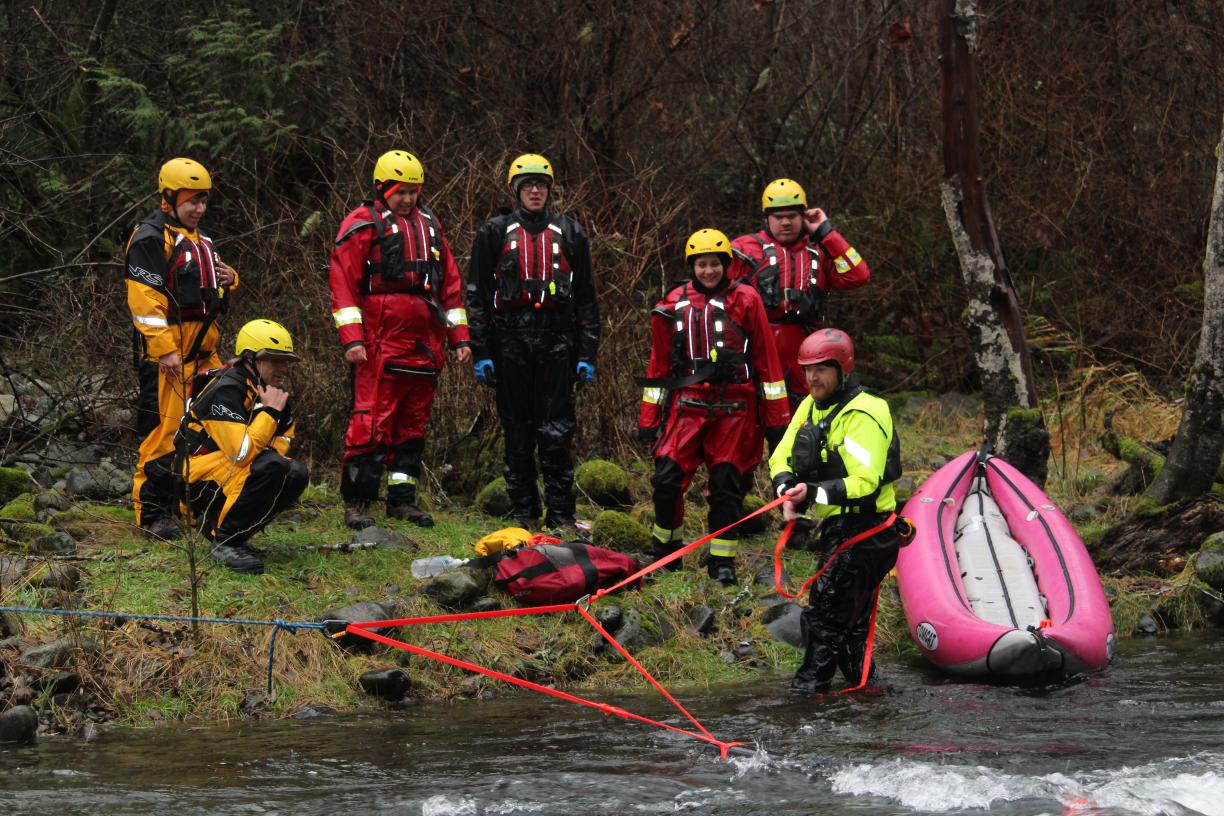
Fellow student Candace Newman, on the other hand, has spent the last six years working outdoors, and was fully equipped with warm clothing. She was no better off than Chip in the end, however.
“My rented dry suit had several holes in it, and I got soaked!”
It didn’t help that Candace got caught off guard the first day of the training, when she and another student fell while crossing the river.
“It was raining hard, and the water was flowing really fast. He slipped, then I slipped, and over we both went. It was so cold!”
It was a good experience, she says.
“It was perfect. It really helped to understand how that can happen in an instant, and what you need to do. We managed to save each other, fortunately, and get over to the other side by ourselves.”
Chip also survived the cold, and loves the skills he has gained. It’s a great feeling for someone who never thought he might one day become a qualified environmental steward for his First Nation. If he continues his studies, he might even become a Guardian with a university degree: another option he had never considered prior to enrolling in the STTP program.
A cohort of stewardship students
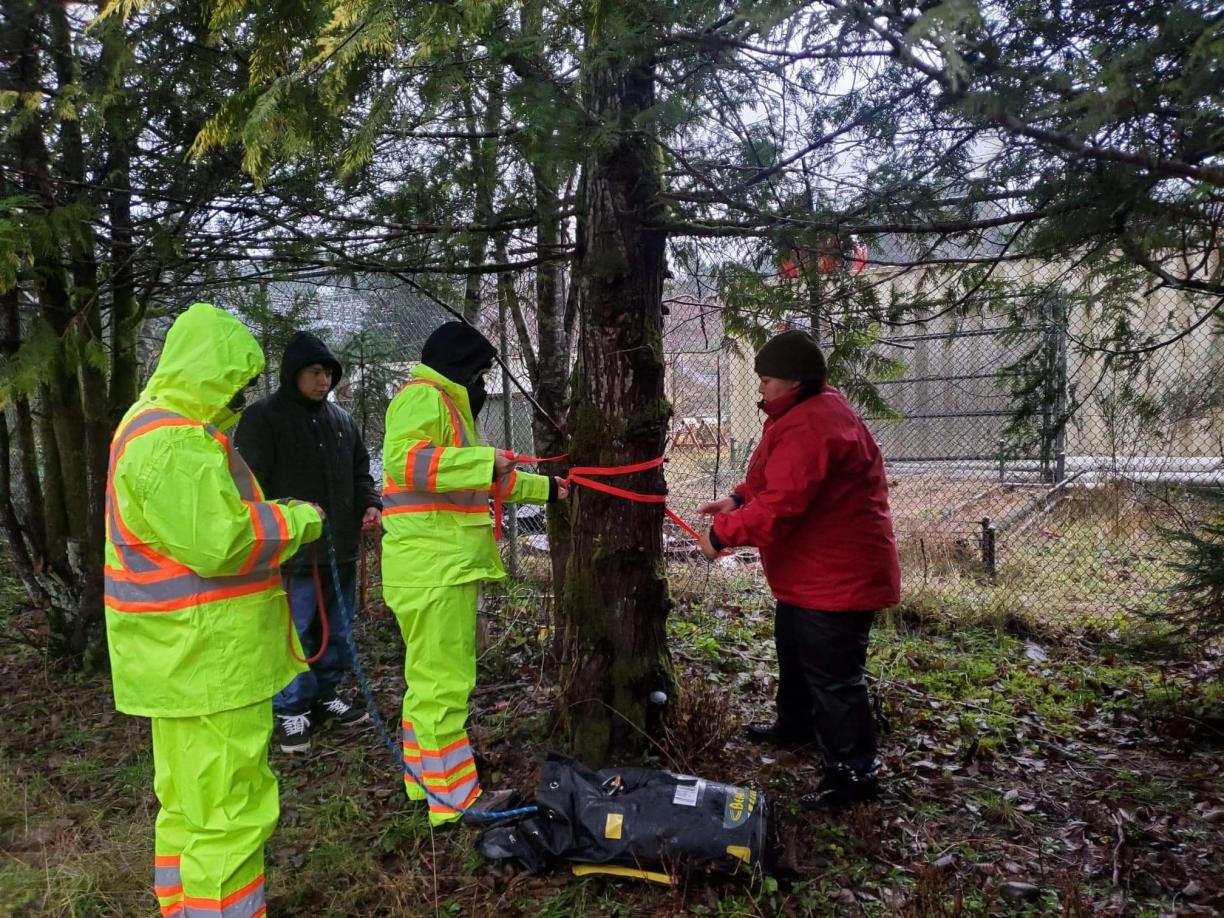
These students are part of a cohort of four women and 12 men, most of whom are from the Nanwakolas member First Nations, all participating in the third STTP administered by Vancouver Island University (VIU). Two students are from the Wei Wai Kai Nation, and the others are from Quatsino and Kwakiutl First Nations. Ranging in age from their teens to fifty-year-olds, they are following in the footsteps of 26 graduates of the first two cohorts, who participated in the program between 2015 and 2018.
Candace, Chip and Christina Speck-Green, like many of the younger students, are eager to become professional Guardians and work for their respective First Nations. Other students are already working as environmental stewards but are eager to build on their existing experience and knowledge with more hard skills and formal qualifications.
Christina was hired by Tlowitsis Nation to be a Junior Guardian summer student in 2020.
“I was unsure of what I signed up for, but quickly learned about the wonderful opportunities within the Guardian program,” says Christina.
Her goal in enrolling in the STTP is simple, and powerful. Having been brought up with old-style teachings from her grandparents, she says: “I want to help protect our remaining territory and to ensure our future has a thriving, healthy ecosystem to visit and protect.”
What is the STTP, exactly?
The STTP provides training in everything from environmental assessment to how to operate and repair small marine engines. Students learn hard skills such as data collection and inventory monitoring techniques, biological sampling, fish identification, archaeological inventory methodology and use of field equipment. They also acquire other skills that are essential to effective resource stewardship, including effective communication methods and management of safety protocols. Equally importantly, they learn about the relationship of Indigenous governance and cultural laws to their scientific work.
The objective of the program is not only to provide the necessary skills and knowledge to work as resource stewards in their respective territories, but to enable work opportunities following graduation in fields such as fisheries technicians, heritage surveyors and environmental monitors. By offering industry-recognized certificates and university credits that could be applied to further post-secondary studies, the program provides multiple opportunities to its participants when they graduate.
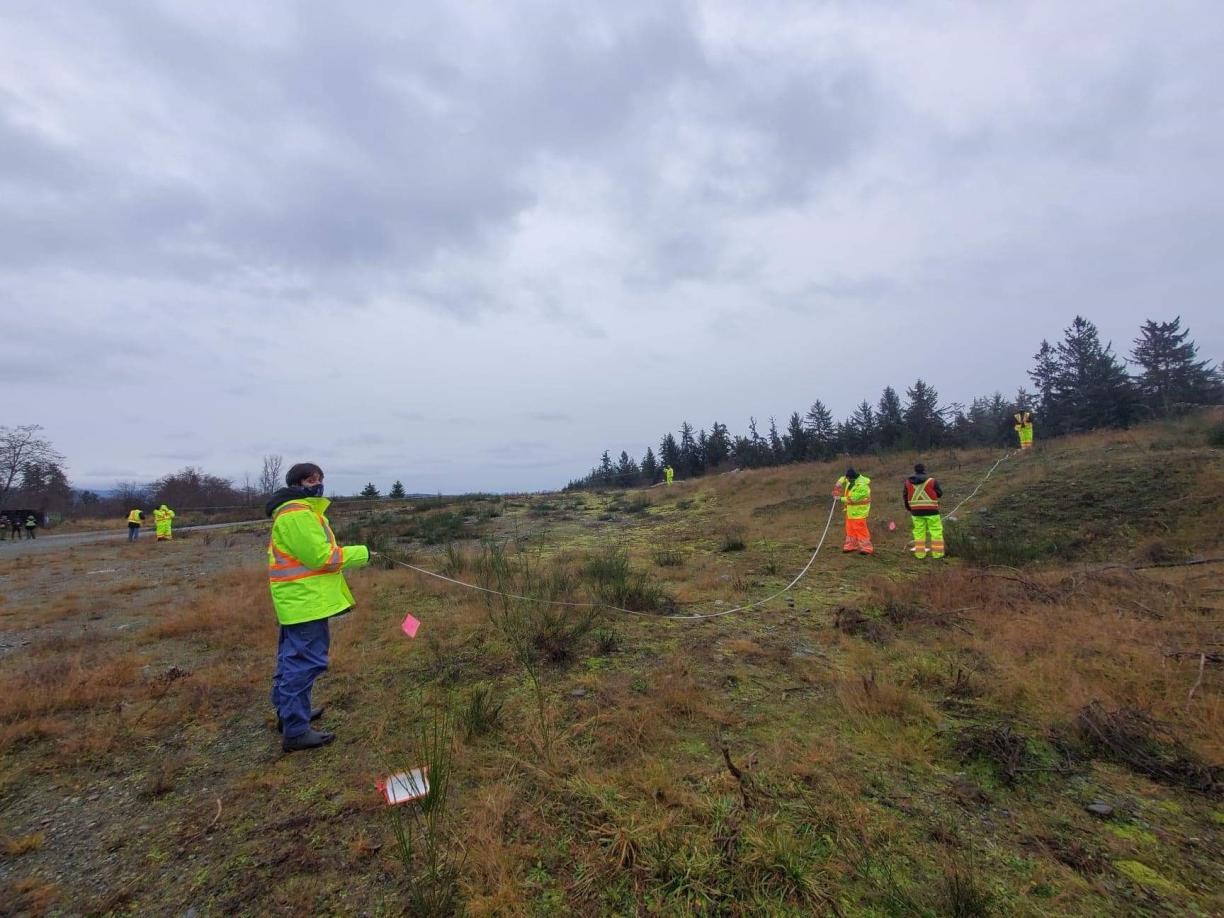
Loving every minute
Four weeks into the program, Candace, Chip and Christina all say they are loving every minute of it.
“The work is intense,” reflects Candace. “It has been hard. At the same time, it’s only been a month, yet I feel so satisfied. I feel a lot more confident already. I feel like I have accomplished something real.”
“The orientation course was wonderful,” adds Christina. “In those two days we really got to know one another, share laughs and have fun.” For Christina, the camaraderie of the cohort has been a highlight: “Honestly, the best part so far is making friends. Being in a class full of “kwaks” has made me so happy. We all share similar humour and enjoy making things fun.”
“It’s a fantastic group of people,” enthuses Chip. “It’s hard work, and you end every week absolutely exhausted, but it is amazing.”
Chip has had to work at his note-taking skills, which he says were poor. He understands now why it is vital to get that right.
“It’s really important to have accurate notes in compliance monitoring, for example,” he explains. “You have to record all the little details because the information might be important later, if it gets used in court, for example.”
He’s justifiably proud of his efforts: “I scored 4.5/5, so that’s pretty great!” he says with a satisfied smile.
The STTP organizers are thrilled. Despite the intensity and the hard work, every student has been attending classes daily so far, without fail.
“On the first day of class, every single student showed up, on time. They have all showed up on time every day since,” remarks Maureen Thomas. “That’s fantastic, and it really shows their commitment to succeeding when we all know it isn’t easy for any of them.”
The STTP isn’t easy from any angle you look at it. As for the first two series of the STTP, the courses are challenging. In fact, two additional credit courses have been added this time around, including leadership and interpersonal communications. At the same time, most, if not all of the students have never previously undertaken post-secondary studies. Like many First Nations people, some of them have had negative experiences at high school and can lack confidence in their learning capabilities as a result. Yet day after day, for over a month, every student has been turning up enthusiastically to classes, and everyone is doing well so far. What’s the secret to this success?
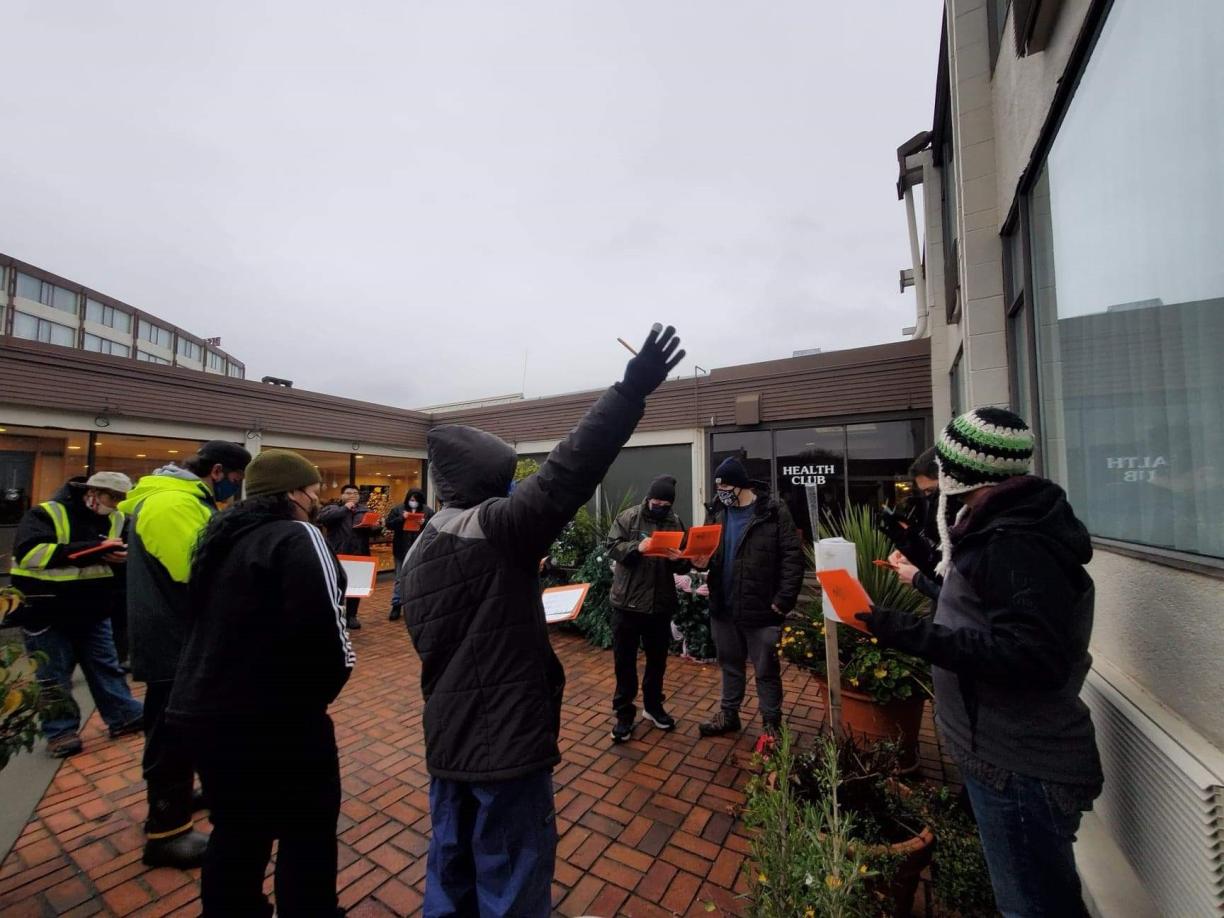
It’s all about the students
Looking at what they learned from the first two cohorts of the STTP, including feedback from students in the program, VIU organizers and Nanwakolas staff structured the third cohort to minimize learning barriers and at the same time, to maximize logistical and cultural assistance to the students, to help them feel safe, supported and as free from stress as possible.
First of all, instead of the courses being stretched out in part-time segments over two years like the previous programs, this time the STTP is being run full-time – from 8:30 am to 4:30 pm, Monday to Friday – over just five months. Graduation in April 2021 is a goal that feels within reach right from the start. Financial support is also being provided so that the students don’t have to juggle work and studying but can instead commit 100% of their time to the courses.
In addition, it was recognized that increasing in-class support for the students would be vital. VIU’s Maureen Thomas is aware of the challenges that Indigenous students can face. It’s a fact, she notes, that Indigenous students face learning challenges most non-Indigenous students never experience, including the traumatic impacts of colonization – the legacies of the residential school system among them – and ongoing systemic racism. Some of them have been disconnected from their own culture and family history. The mainstream schooling system takes none of this into account and can set up Indigenous students to fail.
Maureen and her team at VIU have been proactive in ensuring all the students and instructors have the supplies they need, for example, and are on hand to help problem-solve any unforeseen issues that may arise. Nanwakolas STTP training coordinator Charlene Everson takes care of administration and logistics, including ensuring out-of-town students have accommodation during the week and that no-one has a problem getting to classes in Campbell River and to field training sites. Angela Davidson, a previous graduate of the STTP program, sits in on all the classes as student support.
Gloria Cole is participating as a cultural adviser, with experience teaching previous cohorts. Last but not least, Noelle Hanuse provides counselling and other wellness support as needed and wanted by the students. In addition, instructors for all the courses participated in a trauma-informed cultural safety workshop prior to the start of the program, helping them to gain some understanding of the students and their backgrounds.
All of the staff involved believe that this level of support in the STTP is already making a real difference to the students and will help ensure they have the same opportunity to succeed as anyone else in tertiary education. “They have every intention on our success,” observes Christina of the support crew. “They have made my personal learning experience safe.” So far, the results are speaking for themselves.
The Bakwam Accord, and a cultural approach

During orientation, the students worked together to develop a set of shared values, which they named the Bakwam Accord. Entitled “’Namwayut – We Are All One,” the Accord is introduced to each new instructor in the program, and its contents reviewed with them.
The Accord emphasizes the importance of maya’xala (respect) for all living things and for each other, inside and out of the classroom. Amongst other things, it lays out the ways the students wish to be treated, and their expectations of how they will treat each other – with kindness, for example. It also describes their expectations of themselves: to work hard, to be fearless, and to lift each other up in their efforts to succeed.
“We all contributed to it,” says Chip. “It was really a neat exercise. I think it helps the instructors understand us better when they read it and what we need and want from them.”
For Christina, the Bakwam Accord laid out a very important value for her as a student.
“Having a safe learning space is so important. In the past, I could have learned so much more if I had this. I withheld my questions or comments out of fear of judgment and criticism. With our support system and general appreciation for one another I have been able to express ideas, ask questions, and even help others.”
The Bakwam Accord fits neatly with the cultural approach taken to the program, says Gloria, who spent the third week of the program with the students.
“I came in as an instructor, to teach and for us all to learn about who we are, and the cultural aspects of being Indigenous people. Our culture, our language, our values, are all so important,” she adds. “They go hand in hand with connection to the land, and protection of it.”
This vital aspect of the program is integral to every course, and the approach the students take to learning.
“It’s so important,” says Charlene, “because it reflects who we are as Indigenous people. Our way is to learn together, be supported by each other because of our shared values and history. Our laws tell us that we are all one, and we belong to the land, the places of our origin stories. Knowing and understanding that is so important. It’s how the learning is delivered to the students, through that cultural understanding and those values.”
Gloria set the students two tasks, researching and designing vests with their family crests – she hopes they will wear them upon graduation – and presenting a story board about their family and culture to the rest of the class.
“The idea was for them to share who they are with everyone, as Indigenous people, with pictures, or symbols, whatever felt right to them.”
That was anything but easy for some of the students. The tragedy and history of the past and what had happened to their families triggered tears and heartache. Noelle and Gloria were both on hand to provide comfort, and consistent with the Bakwam Accord, other students wrapped themselves around their colleagues as well.
“There were many emotions expressed,” recalls Noelle. “But to be heard was the most important thing. They all did the most beautiful presentations in the end. Being able to share and be heard – that removes so many barriers to being able to move forward and feel valued and confident they can do this work despite everything.”
Chip Mountain, for example, grew up with next to no cultural involvement with his First Nation.
“I did find it difficult,” he reflects. “I have had such a lack of connection.”
Chip was relieved to discover that he wasn’t the only one, however. He also came away from the experience with a better understanding of himself, and determined to find out more.
“I could see what I had missed out on, but now I am really getting into finding out as much as I can so I can pass that on to my kids. It’s really good.”
“Big sister” Angela: having support from someone who’s been there, done that
“Having Angela there with us has been awesome,” says Chip. “She’s so helpful and knowing she has been through it all as well, makes her one of us, one of the team.”
Angela understands the importance of having someone like her playing the role of “big sister:” “When I did the course, [former Nanwakolas staff] Greg [Johnson] was there, being a big brother to us, making sure we had everything we needed, and helping us when we were struggling. The difference is that Greg was not just doing my job but also Charlene’s job on top of his regular work, so couldn’t always be there. I get to do just this, full time, every day.”
It also makes a difference that Angela knows exactly how the students feel.
“I had a hard time, too. The science was really heavy. I didn’t think of myself as a good classroom learner and had to work through all of that as well, so they know that, and it helps them feel comfortable with me being there. They know I’m safe and all about helping them succeed.”
Angela is blown away by how connected the cohort of students has been since the first day of class, despite not everyone having met before, and the barriers of physical distancing and masking to observe COVID-19 safety protocols.
“One of the things the class does every day is check in with each other at the beginning, and before they head home. They share how they are feeling, and things about their lives. It is amazing, and I think it is a big part of what keeps everyone coming back each day, on time, doing their homework and being ready to work together in the next class. That, and they really have taken on board that respect includes respecting the instructors, and the organizations that have contributed to their being there, either with scholarship money, or equipment. They have a responsibility to live up to that, so that means showing up and doing the work, and taking care of each other.”
There is a real sense that no one succeeds unless everyone succeeds, but that everyone learns in a different way and has different challenges. That’s a key aspect of both the Bakwam Accord and the way the classes are structured.
“The classes are customized to these students,” observes Angela. “The instructors are really open to different learning styles, and understand that culturally, everyone learns differently, so there is a real focus on the individuals.”
Dreaming of the future
“This training,” says Maureen, “will improve every aspect of the students’ lives: financial, interpersonal, employment, self-esteem, their family connections, everything.”
Christina intends to go back and keep working for her Nation after she graduates, protecting the territory to the best of her ability. Candace is looking forward to working in the outdoors again, as a fully qualified environmental steward: “At graduation, I think I will feel confident to work in the field as a Guardian. I hope people see me as a professional, that there is confidence in us as stewards of the land.”
Chip has already decided he would like to consider carrying on his post-graduate education.
“I have already told Maureen if I keep doing well, I would like to do a bachelor’s degree, maybe in science.”
In the meantime, he’s also looking forward to the rest of the course.
“I know it is going to get even more intense but so far it is all so great, I just love all of it, and I am excited for what is coming next.”
Charlene is looking at what the future holds for the students as protectors of their territories.
“This program is such an important part of the First Nations becoming self-governing communities, taking charge, steering the course of direction for the lands and waters. This gives these students, as members of their Nations, the power to know what to do to protect them. It’s wonderful.”
Gloria is thrilled about the success of the program so far. She’s happy about what the program can offer both these students, and others who might be thinking about stewardship careers.
“I would say to our people with a passion to be in the outdoors, who might struggle with classroom learning in the mainstream education system, then this program is for you,” says Gloria. “It is so grounded in the culture. It will help them continue their journey in life.”
Part 2: A Family of Graduates
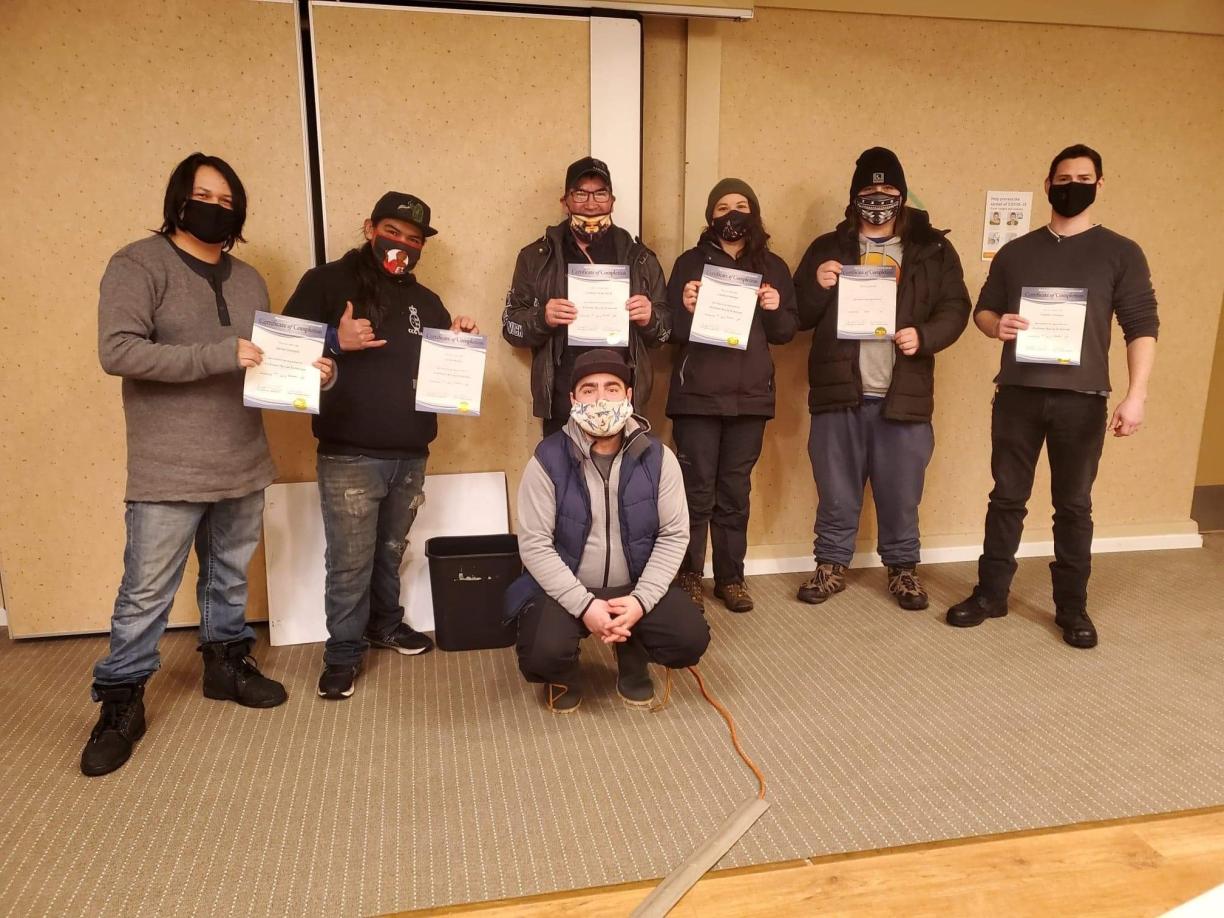
“Sixteen strangers who didn’t know each other’s names walked into that classroom last October. By April, we had grown into a family. We may have graduated as individuals, but we did it together. We completed that whole program as a family.”
– David Cliffe, Wei Wai Kum: graduate and class speaker (by popular vote), 2020-21 Vancouver Island University (VIU) Stewardship Technician Training Program (STTP)
At a casual glance, it looked like a typical 2021 Zoom meeting: a shifting mosaic of grainy faces collected together on computer screens, and the usual litany of “Can you hear Me’s”, “Turn off your mutes”, Internet slips, and other technical glitches, all disrupting the flow of conversation. Scattered across the upper half of Vancouver Island and further afield, some attendees were at home, some were in their offices, and some had children and pets peering curiously at the pictures moving across the screen in front of them.
But the graduation that more than 80 people had gathered together to witness was anything but typical. In a spacious but windowless hotel conference room in Campbell River, 16 students and some Nanwakolas Council staff were gathered in front of a large “Congratulations!” banner slung across one wall. Twinkling fairy lights and decorations had transformed the otherwise bland chamber into a festive and celebratory space. Celebrations were in order: in a first for the program, everyone in this third cohort of the VIU STTP had successfully completed the program, passing every course with flying colours.
Savoring the anticipation of receiving their diplomas, the beaming students waved excitedly at four different screens in the room, enthusiastically calling out to instructors, friends and proud family members. Everyone was beaming. Occasionally, they erupted into outbursts of disbelieving, joyful laughter. They had successfully made it through six very tough months of hard work, both physically and academically. Happiness and pride reverberated around the room and emanated from every screen.
Fulfilling the Vision
Finally, the graduation ceremony for the 2020-21 STTP class got underway. Prayers and songs were followed by acknowledgements of the hard work by all involved, and of the land and waters that the students had vowed to help protect on behalf of their respective Nations.
In his opening comments, Nanwakolas President Dallas Smith expressed what many might have been thinking.
“I am feeling a lot of emotion right now. Last time we celebrated graduates of the STTP, we were in the bighouse, all face to face. But this is still a powerful moment for all of us, and I would like to thank each of you for making it a reality.”
Dallas reminded everyone that when Nanwakolas Council first began its work in 2007, that work was largely confined to land use planning.
“We realized over the years that we needed boots on the ground and eyes out on the water,” he continued. “We understood we couldn’t complete our vision without people like you becoming part of a network of stewards, working across our territories, who understand what needs to be done to take care of our lands and waters. The work that you will be doing will help us immeasurably to plan for the future and protect our territories.”
Wei Wai Kum Chief Christopher Roberts echoed those words.
“What you do is so important. As stewards and Guardians, you will be at the front lines of our territories, gathering information and bringing it back to us. You are the game-changers. This is how we go about reclaiming our stewardship responsibilities and rights in our territories. I thank you for it. I can’t begin to say how much of an achievement this is, especially during COVID,” concluded Chief Roberts. “You will retain these friendships, this network, and the skills and experience you have acquired, for all your lives.”
All for one, one for all
Last January, students and staff involved with this cohort talked about some unique aspects of its delivery, and how those factors were already contributing to its success just five weeks into the program.
A shorter, full-time program with financial and logistical support for the students, a wraparound team of support staff, and a strong cultural approach to the instruction all lent themselves to the students feeling strong and confident. Those factors kept the students highly motivated to show up every day on time, complete all the coursework, and see the program through, even during challenges such and illness and bereavement.
Equally important, the students had created their own agreement with each other, called the Bakwam Accord. They promised to respect each other, the staff, and the instructors. Perhaps the single most important commitment they made was to ensure that every person in the cohort would have to succeed: that it was their job, and their commitment, to help each other through.
After the graduation ceremony was over, some of the students and support staff reflected on how much that had contributed to the whole class successfully completing the program. David Cliffe, 49 years old, is a former commercial fisherman who became a Wei Wai Kum Guardian in 2020. David signed up for the program because, he says, “As a person, I wanted to be a better human being. As a Guardian, I want to keep working on changing the world.”
“The Bakwam Accord was really important,” adds David. “We knew that we would be taking what we learned out into the world. How we would behave was so important. The Bakwam Accord helped us live that way every day through the program, together. We learned to share with each other, to work together safely and respectfully and to help each other progress.”
Candace Newman agrees.
“Each of us had different strengths, and we all learned to use those strengths for each other,” she observes. “If someone was struggling, the rest of us were there to lift them up. We worked together to make sure we would graduate as a team. Of course, I think everyone would have succeeded individually, but we were so much stronger together.”
“We all came from different ages and backgrounds,” adds Christina Green, “but not one single person in our class came away learning more or less than anyone else. That key value of respect – we all had that within us when we walked in the doors, so that made it easy to become one.”
For Christina personally, that team approach had benefits in multiple ways.
“The introduction to parks course was hands down the most difficult course I have ever done,” she says. “I don’t know the first thing about it, it was completely blank slate. It was so academically grueling, I honestly didn’t know if I could pass it.”
Others in the course did have a knack for it.
“Chip Mountain just got it, he was amazing. He really helped me through.”
The students, says Christina, decided that if one teammate wasn’t getting it, no one was: “We just took a lot of pauses over those eight days to make sure everyone was keeping up, and if they weren’t, to catch them up.”
Of course, Christina found strengths and capabilities of her own that she in turn could offer her classmates. That was as much a gift to her as learning from them.
“I did not previously have good experiences in education. Before I walked in through those doors last October to start the program, I had trouble accepting that I am a smart, capable person,” says Christina. “But then I started seeing how much everyone respected and trusted me and my abilities. They would ask me questions, and I could answer them. That sparked the fire in my eyes to see myself as a very smart and capable person. It changed everything.”
Noelle Hanuse provided well-being support to the students throughout the program.
“It was such a pure pleasure to be part of this amazing group,” she wrote on the graduation message board. “They are so inspiring and full of life and promise.”
Cultural adviser Gloria Cole felt the same way.
“Those students just held each other up, right from the beginning. It was such a beautiful thing to witness.”
Onwards and Upwards
At the graduation ceremony, Nanwakolas President Dallas Smith made a point of acknowledging the funders who had made it possible not only to undertake the program, but for those not already working as full time Guardians to follow it up with a work placement with their Nations over the 2021 summer season, putting into practice all their newfound skills and qualifications.
“I’d like to thank VIU for helping us keep people at home, in jobs in our own communities,” said Dallas. “Thank you to EleV-Mastercard Foundation for stepping up to invest in our dreams. It’s good to see corporations asking how they can help us, without telling us what to do. Nature United also invests in longstanding relationships with us like this. Not least of all, I thank the B.C. Ministry of Advanced Education and Skills Training for playing by our song sheet, working to our way of delivering this program and not asking us to fit into one of yours.
“Finally,” he concluded “I thank the students for the return on all of the investments: for your commitment, your respect for the funders and the program, and by graduating, showing that it has been more than worthwhile.”
Flushed with newfound confidence in their capability, several of the students are planning to further their post-secondary education in stewardship-related studies. Chip Mountain, who says “there wasn’t one part of the program that I didn’t enjoy!” is planning to update some of the courses next winter, after his summer working with Mamalilikulla First Nation. In 2022, he plans to enroll for VIU’s Resource Management Officer Technician Diploma.
Indulging her discovered passion for archaeology, Christina will begin her Bachelor of Arts in Anthropology this fall. She hopes to keep working summers for Tlowitsis as a Guardian.
“I want to just help whatever way I can to support protecting the territory, and growing the team, encouraging the youth to get involved and take up opportunities like this one.”
The next cohort
For people who are thinking about either beginning a career in stewardship or expanding on their existing skills and experience, VIU and Nanwakolas Council are already working on creating future training opportunities.
Maureen Thomas is VIU’s STTP Coordinator. She is thrilled with the outcome of this cohort.
“We consulted with many elders at VIU and in the community when we were putting this together, and they all said, create a pathway to higher learning, and build capacity in the communities, by building a family. That’s exactly what happened. The students created the family. All of them have plans to work in their communities, and the fact that several of them are continuing their studies is a huge pay-off for everyone’s hard work.”
Maureen wasn’t able to attend graduation: “I didn’t get to say goodbye! I do want to tell them this. In Coast Salish cultural instruction, you learn that in life you will experience joy and sorrow, happiness and sadness. That is life. Somewhere in between is a spiritual and emotional balance that is important to remember. It is up to them to take what they have learned out into life and use it to manage that balance, and to grow what they have learned. If they remember that, and how they found that balance during the program, in the hard times as well as the good ones. They will always remember that anything is possible.”
Anything is possible
For anyone out there wondering if the STTP program is something they could or should try doing, the answer, says Charlene Everson, Nanwakolas STTP Project Coordinator, is: “How do you know if you don’t try? Just do it!”
In all seriousness, says Charlene, the program provides good, solid transferable skills, even for someone who doesn’t end up as a Guardian.
“It’s a real pathway to all sorts of work options, whether in stewardship or otherwise. There are jobs waiting for everyone who does this, or like some are doing, it’s a steppingstone to even more qualifications in whatever field inspires your passion, maybe science, maybe archaeology, whatever it is.”
Charlene emphasizes, as do all her colleagues, that the STTP is an Indigenous designed, led and delivered program for Indigenous students.
“It is such a safe, culturally strong and supportive environment. You make friends and become part of a lifelong network.”
Angela Davidson, a former graduate of the program, attended all the classes with the students as part of the staff support system. She is absolutely unequivocal about the magic of the program.
“Such a core aspect of it is the space for connection between the students to come together as a way to overcome the challenges they might face, or their negative experiences in the past,” says Angela. “That sense of building family – it’s just about as important as getting the diploma. It should be on the program posters!”
Angela also echoes Charlene’s thoughts: “It is such a unique program, as an Indigenous program. Being with people like you, with the same cultural background, similar experiences, makes such a huge difference to being able to do the work. You come out of it feeling like you can do anything.” She points out that one of the students plans to study sports therapy at the University of Victoria, and another is going to combine working in stewardship in the summers with opening his own auto mechanic’s business. “You see, you can do anything with the skills and confidence you gain through your hard work.”
There is no doubt it is hard work, say all of the students. “But it is so worthwhile,” says Candace. For people who might be fearful whether they are capable, she says simply: “Don’t be afraid. You can do it. Anyway, think of it this way – taking care of our lands and waters is far more important than any of our own personal fears.”
Everything in the program caters to how Indigenous students want to learn, she says: “We are very hands-on, and the instructors really worked with us to help us learn that way. Even the academic parks course, the instructor took that on board and worked with us on practical scenarios to get across the content rather than just lecturing us from the books.”
“Just jump in with both feet!” exclaims Chip Mountain enthusiastically. “You get to go to work every day with amazing people, all with different backgrounds but similar interests to yours. I know it might feel like unknown territory but the people around you will soon change that. They will help make you comfortable so quickly.”
“Put it this way,” muses David Cliffe. “I get to go to work every day in this job as a Guardian where I hear the birds sing, I feel the sun or the rain on my face, I hear the wind and the water and feel the energy of the forest. It’s all so beautiful. And you get to keep working on changing the world at the same time. How could you not want to be a part of it?”
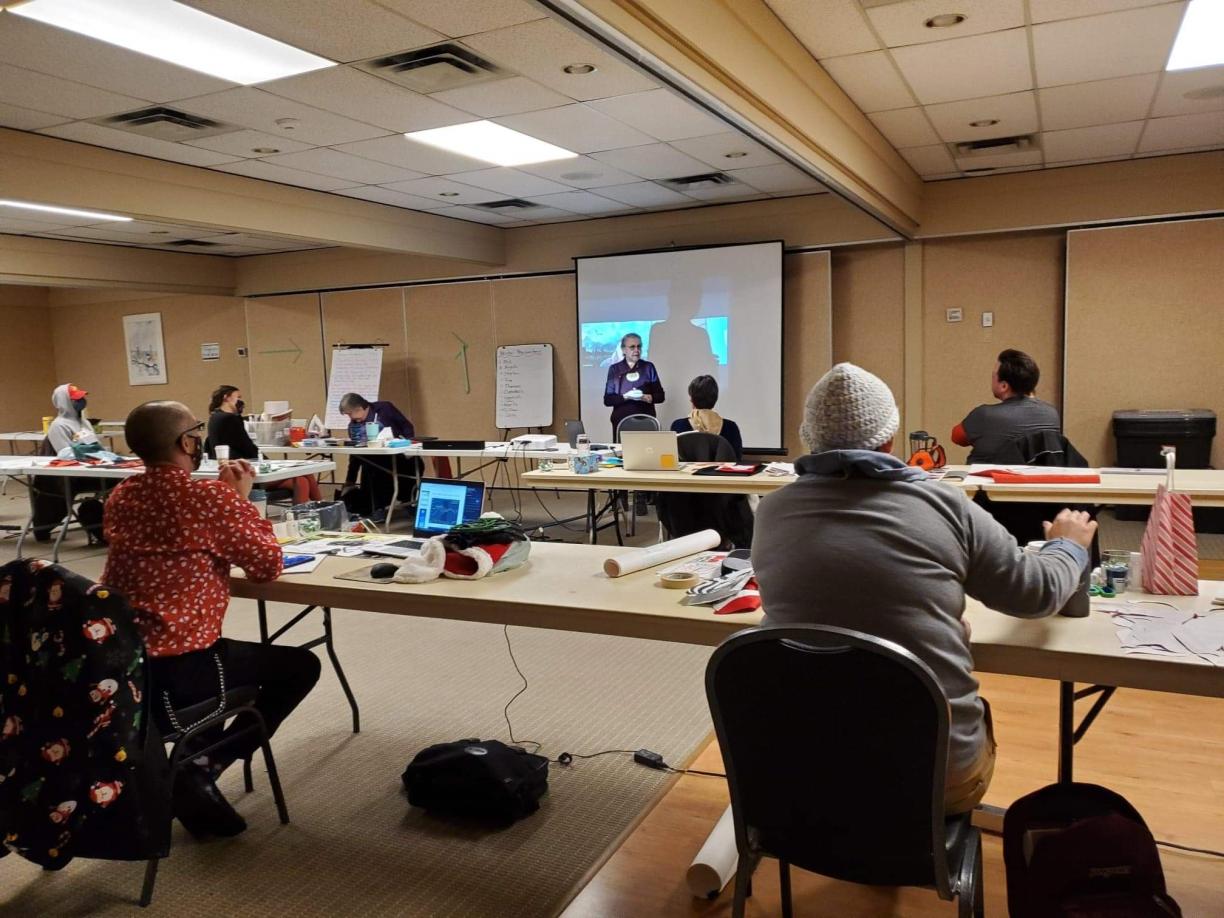
View the original stories at Nanwakolas.com:
